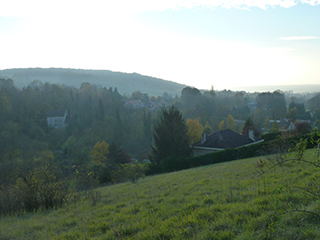Prochain point : lat="49.066935" lon="1.721836"

Panorama of the municipality
The municipal area of Vienne-en-Arthies was created at the time of the Revolution, by merging the hamlets of Vienne, Chaudry and Millonets previously attached to the municipality of Vétheuil.
The town hall-school was built in 1873 in Millonets, the most central part of the village, at a time when children had to walk to school. Previously, there was only one class in Vienne, and the children of Chaudry went to school in Villers while those of Millonets went to Vétheuil.
The landscape
Vienne-en-Arthies is named after the former Arthies forest, of which the surrounding woods are the vestiges. From the mounds of Arthies, rising to 200 metres, you descend through multitude of wooded valleys to the Seine valley. Vienne-en-Arthies is located at the centre of the watershed of the brooks of Vienne, Chaudry and St. Cyr. On the hills there are cultivated areas and the old Vaulézard farm. Away to the west, we see the chevet of the church of Vétheuil, the nearby community that is the easiest to get to.
Because of its position and hilly terrain, Vienne-en-Arthies has always been off the main transport routes, whether road or rail, allowing it to preserve its rural character, vexinois habitat and the charm of days gone by. The many trails and unspoiled nature make it a popular place with hikers.
Economic activities
The main crops in the nineteenth century were wheat, rye, barley and oats. Fodder beet was grown for cattle, and potatoes and carrots for subsistence. There were also apples, pears, cherries, plums and some apricot trees. Agricultural production was primarily sold in the markets of Mantes and Magny-en-Vexin. Vineyards were an important part of the landscape until the late nineteenth century when only a tenth of the vineyards remained, mainly due to the ravages of phylloxera. At that time the meadows were sown with alfalfa and sainfoin for the grazing of cattle, primarily for meat.
Vienne-en-Arthies revolved around water. Many jobs were created to operate the small mills and factories: the manufacturing of compasses, pins, corkscrews, combs or clogs according to the times. These trades of the past have now disappeared and, today, with the lack of business, small craft activities are the only form of local employment.





